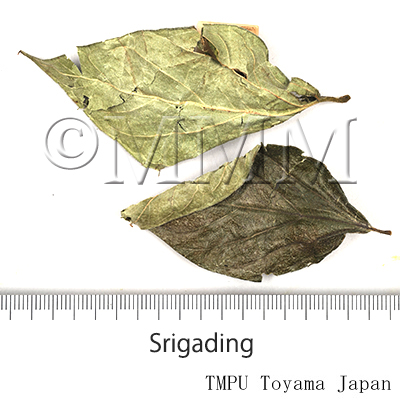Crude drug sample data base
※Click on the image to enlarge it.
The capital city, provincial capital city or the representative
location of its administrative area is indicated.
location of its administrative area is indicated.
Production area information
Republic of Indonesia
https://ethmed.toyama-wakan.net/img/pin_san.png
-7.0051453
110.43812539999999
Collection information
Republic of Indonesia,Central Java Province
https://ethmed.toyama-wakan.net/img/pin_nyu.png
Scientific information data base
| Crude drug name | Indonesian name, English name | Srigading, Tree of sorrow | |||
|---|---|---|---|---|---|
| crude drug image |
| ||||
| Original plant name | Nyctanthes arbor-tristis Linn. | ||||
| Family name | Oleaceae | ||||
| Used part | Flower, leaves, stem bark | ||||
| Distribution area | The plant is native to India and distributed wild in tropical areas. It is now cultivated as ornamentals from lowland up to 500 m altitude. | ||||
| Description | The flowers are fragrant, waxy white with 6-7 petalled star-like corollas and orange tubes. They usually blossom in the evening and will fall on the ground around the tree in the morning. The plant is a shrub, up to 9 m tall; it has woody stem, round, branches, hairy, pale white in color. Leaves simple, ovate, rounded base, apex acuminate, upper blade rough, green, bitter [207]. | ||||
| Specific actions | Flower and leaves: emmenagogue [231]. Stem bark: expectorant [231]. | ||||
| Frequency in use | Moderate | ||||
| Common uses | The corolla of the flower is used as a food coloring and gives a yellow color [201]. The yellow pigment is similar to that found in turmeric [201]. | ||||
| Side effect | Not recommended during pregnancy [231]. | ||||
| Pharmacological effect | An in vitro study to investigate the effect of infuse of leaves (5% and 10%) and flowers (0.5%) on the contraction of uterine smooth muscle in rabbit showed an increase in the amplitude of the contraction. The water soluble portion of the alcoholic extracts of the leaves of Nyctanthes arbour-tristis was screened for some CNS activities. Results showed that they produced general depression of spontaneous motor activity, increase pentobarbitone sleeping time, exhibit hypothermic effect and purgative activity [PMID: 12127232]. The alcoholic and aqueous extracts of the leaves of Nyctanthes arbor-tristis protect the liver of rats from toxic effects of carbontetrachloride by the reduction of elevated levels of serum glutamate pyruvate transaminase, serum glutamate oxaloacetate transaminase and serum bilirubin at a dose of 500 mg/kg body weight [Indian J Pharm Sci.]. Study on the immunomodulatory property of aqueous extracts of leaves and flowers of Nyctanthes arbor-tristis revealed that the leave extract was the best immunopotentiator and anti-immunosuppressive, while the flower extract was an anti-inflammatory. Various immunological parameters were studied in treated and untreated mice in the study [The 4th World Congress on Inflammation]. The chloroform and ethyl acetate extracts of the flowers of Nyctanthes arbor-tristis showed interesting antibacterial activity against some gram-positive and gram-negative microorganisms, while the petroleum ether, chloroform and ethyl acetate extracts showed a significant cytotoxic activity [PMID: 11395266]. Study on the effect of the water soluble fraction of the ethanol extract of Nyctanthes arbor-tristis on tumor necrosis factor-alpha level in plasma of arthritic and soluble protein A-treated Balb/c mice showed a consistent depletion of tumor necrosis factor-alpha from the host plasma, also in the plasma of SpA-treated mice . The extract also reduces plasma interferon [PMID: 9174977]. | ||||
| Medical system | Indonesian medicine (Jamu) | ||||
| Traditional usage | Flowers showed good results in inducing or hastening menstrual flow especially for young girls during puberty; decoction of dried or fresh leaves and flowers are used after childbirth to treat fever. Infusion of the flowers is used to treat skin rash caused by leprosy and others [201]. Flowers and leaves are also applied for rheumatism and as a diuretics [207]. Barks are used for cough and bronchitis [231]. | ||||
| Formulation | 1) Menstrual disorders: 1/5 handful of flowers, 3/4 teaspoon of Nigella sativa seeds, 1/2 teaspoon of fennel seeds, a little amount of Alyxia reinwardtii bark, 2 Bixa orelana flowers , 2 Citrus aurantium fruits, sugar. All ingredients are cut in pieces and boiled with 3 glasses of water to make 2 1/4 glasses of decoction. Strain, drink 3/4 glass of decoction 3 times a day. 2) Fever after childbirth: 10 grams of fresh flowers are boiled with 2 glasses of water to make a decoction. Drink 1/2 glasses of the decoction twice a day in the morning and evening [207]. | ||||
| References | Reference book Tips! | [201] K. Heyne, Tumbuhan Berguna Indonesia, Vols. 1-4, 1987. Diedarkan Oleh Koperasi Karyawan Departemen Kehutanan, Jakarta, Indonesia. Vol. 3, pp 1612-1613. [207] Badan Penelitian Dan Pengembangan Kesehatan and Departemen Kesehatan, Kesejahteraan Sosial Ri. Vols. 1-5, Inventaris Tanaman Obat Indonesia, Jakarta, Indonesia. Vol. 1, Part 1 (2000), pp 171-172. [231] Soedibyo, Mooryati: Alam Sumber Kesehatan: Manfaat dan Kegunaan (Natural resources for health. Benefits and uses). Balai Pustaka. 1998. pp 352-353. | |||
| Research paper | 1. Saxena RS, Gupta B, Lata S. Tranquilizing, antihistaminic and purgative activity of Nyctanthes arbor-tristis leaf extract. J Ethnopharmacol., 81(3):321-5, 2002. (PMID: 12127232) 2. Khatune NA, Mosaddik MA, Haque ME. Antibacterial activity and cytotoxicity of Nyctanthes arbor-tristis flowers. Fitoterapia, 72(4):412-4, 2001. (PMID: 11395266) 3. Paul BN, Saxena AK. Depletion of tumor necrosis factor-alpha in mice by Nyctanthes arbor-tristis. J Ethnopharmacol., 56(2):153-8, 1997. (PMID: 9174977) 4. Hukkeri VI, Akki KS, Sureban RR, Gopalakrishna B, Byahatti VV, Rajendra SV. Hepatoprotective activity of the leaves of Nyctanthes arbor-tristis Linn. Indian J Pharm Sci., 68(4):542-543, 2006. 5. A. Bhatia and J. Kaur: Evaluation of immunomodulatory property of Nyctanthes arbor-tristis. The 4th World Congress on Inflammation, Jun 27-30, 1999, in Paris, France. | ||||
| Last renewal date | 2024/03/13 | ||||




